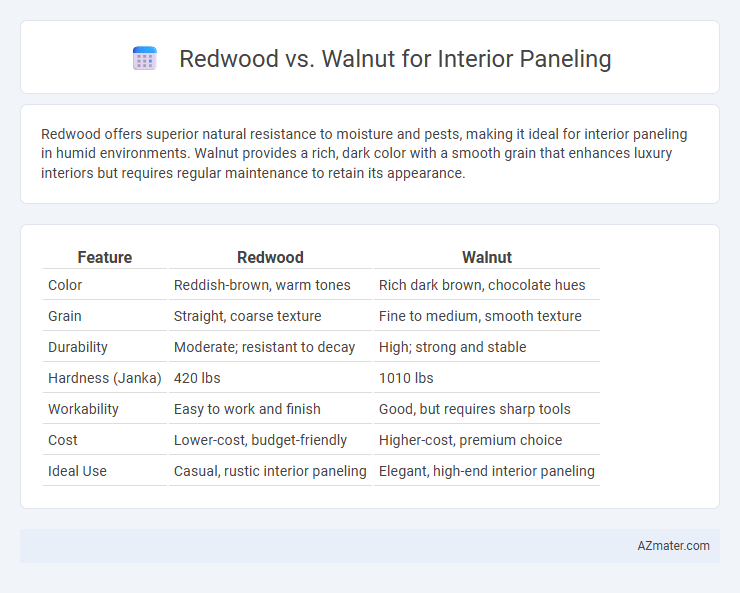Redwood offers superior natural resistance to moisture and pests, making it ideal for interior paneling in humid environments. Walnut provides a rich, dark color with a smooth grain that enhances luxury interiors but requires regular maintenance to retain its appearance.
Table of Comparison
| Feature | Redwood | Walnut |
|---|---|---|
| Color | Reddish-brown, warm tones | Rich dark brown, chocolate hues |
| Grain | Straight, coarse texture | Fine to medium, smooth texture |
| Durability | Moderate; resistant to decay | High; strong and stable |
| Hardness (Janka) | 420 lbs | 1010 lbs |
| Workability | Easy to work and finish | Good, but requires sharp tools |
| Cost | Lower-cost, budget-friendly | Higher-cost, premium choice |
| Ideal Use | Casual, rustic interior paneling | Elegant, high-end interior paneling |
Introduction to Redwood and Walnut for Interior Paneling
Redwood offers a rich, warm red tone with natural resistance to moisture and decay, making it ideal for interior paneling in humid environments. Walnut features a deep, chocolate-brown color with a fine, straight grain, prized for its elegance and durability in high-end interior applications. Both woods provide unique aesthetic qualities, with redwood emphasizing natural resilience and walnut highlighting luxurious, refined finishes.
Overview of Redwood: Characteristics and Appeal
Redwood is prized for its rich reddish hue, natural resistance to decay, and stable dimensional properties, making it an ideal choice for interior paneling. Its tight grain and smooth texture provide an elegant, warm aesthetic while offering durability against moisture and insect damage. The wood's ability to age gracefully with minimal maintenance enhances its long-term appeal in residential and commercial interiors.
Walnut Wood: Features and Distinctive Qualities
Walnut wood, prized for its rich, dark brown color and intricate grain patterns, offers a luxurious and warm aesthetic ideal for interior paneling. Its natural durability and resistance to wear make it a long-lasting choice that ages gracefully, developing a unique patina over time. The fine texture and ability to take finishes exceptionally well enhance walnut's appeal, providing an elegant, sophisticated ambiance to interiors.
Color and Aesthetic Differences
Redwood interior paneling features warm, reddish-brown tones with natural variations and prominent grain patterns that create a rustic, inviting atmosphere. Walnut offers a richer, darker brown color palette with deep chocolate hues and a smooth, straight grain that provides a more sophisticated, elegant aesthetic. The choice between redwood and walnut significantly influences the room's mood, with redwood enhancing a cozy, natural feel and walnut lending a luxurious, modern look.
Durability and Longevity Comparison
Redwood offers superior resistance to moisture, decay, and insect damage, making it highly durable for interior paneling in humid environments. Walnut, while prized for its rich color and fine grain, is slightly less resilient and may require more maintenance to prevent wear over time. Both woods provide long-lasting beauty, but redwood generally outperforms walnut in longevity due to its natural preservatives and structural stability.
Sustainability and Environmental Impact
Redwood offers a sustainable choice for interior paneling due to its natural resistance to decay and pests, reducing the need for chemical treatments and preserving indoor air quality. Walnut, while prized for its rich color and grain, typically has a higher environmental footprint because of slower growth rates and more intensive harvesting practices. Choosing sustainably harvested redwood from certified forests supports carbon sequestration and promotes long-term forest health, making it a greener option compared to walnut.
Installation Considerations: Redwood vs Walnut
Redwood offers easier installation for interior paneling due to its lightweight nature and natural resistance to warping and shrinking, reducing the need for extensive acclimatization and fastening adjustments. Walnut, being denser and heavier, demands careful handling and precise fastening techniques to prevent splitting and ensure a stable fit, often requiring pre-drilling and acclimation to humidity variations. Both woods benefit from professional installation, but redwood's dimensional stability can result in lower labor costs and faster project completion.
Cost Comparison and Value for Interior Paneling
Redwood is generally more expensive than walnut for interior paneling due to its durability and natural resistance to decay, making it a long-lasting choice that justifies higher upfront costs. Walnut offers a rich, dark finish at a more affordable price point, providing excellent value for interiors that prioritize aesthetic appeal and smooth grain patterns. When comparing cost and value, redwood's premium price aligns with longevity and environmental benefits, while walnut's moderate cost delivers elegance and versatility within budget-conscious projects.
Maintenance Requirements and Upkeep
Redwood interior paneling requires minimal maintenance due to its natural resistance to moisture, decay, and insect damage, needing only occasional dusting and a protective sealant every few years to maintain its appearance. Walnut paneling demands more upkeep, including regular cleaning and periodic refinishing to preserve its rich, dark color and protect against scratches and fading caused by sunlight. Both woods benefit from controlled indoor humidity levels to prevent warping, but walnut's denser grain makes it more susceptible to visible wear and requires more attentive care over time.
Choosing the Right Wood: Redwood vs Walnut for Your Space
Redwood offers exceptional durability and resistance to moisture, making it ideal for interior paneling in humid environments or spaces that require longevity. Walnut provides a rich, dark coloration with fine grain patterns, adding warmth and luxury to living areas or office interiors. When choosing between Redwood and Walnut, consider the room's exposure to humidity, desired aesthetic tone, and maintenance preferences to ensure the wood complements the overall design and functional needs.

Infographic: Redwood vs Walnut for Interior Paneling
 azmater.com
azmater.com